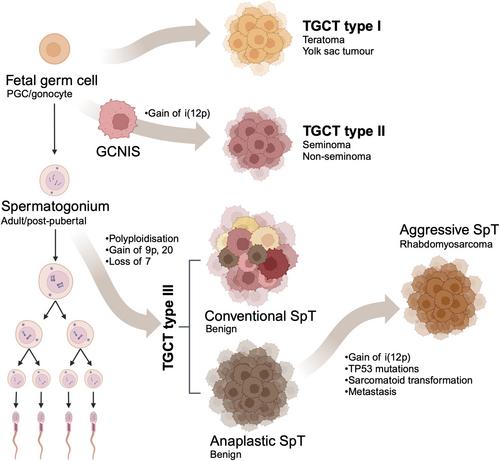下载PDF
{"title":"对非典型精原细胞瘤的新分析揭示了生殖细胞瘤的广泛异质性和可塑性†。","authors":"Ewa Rajpert-De Meyts, Anne Goriely, Kristian Almstrup","doi":"10.1002/path.6262","DOIUrl":null,"url":null,"abstract":"<p>Testicular germ cell tumours (TGCTs) derived from immature (type I) and pluripotent germ cell neoplasia <i>in situ</i> (GCNIS, type II) are characterised by remarkable phenotypic heterogeneity and plasticity. In contrast, the rare spermatocytic tumour (SpT, type III), derived from mature spermatogonia, is considered a homogenous and benign tumour but may occasionally present as an anaplastic or an aggressive sarcomatoid tumour. While various oncogenic processes had been proposed, the precise mechanism driving malignant progression remained elusive until the molecular characterisation of a series of atypical SpTs described in a recent issue of <i>The Journal of Pathology.</i> The emerging picture suggests the presence of two distinct trajectories for SpTs, involving either RAS/mitogen-activated protein kinase pathway mutations or a ploidy shift with secondary <i>TP53</i> mutations and/or gain of chromosome 12p, the latter known as pathognomonic for type II GCNIS-derived TGCTs. Here, we discuss the implications of these findings, seen from the perspective of germ cell biology and the unique features of different TGCTs. The evolving phenotype of SpTs, induced by genomic and epigenetic changes, illustrates that the concept of plasticity applies to all germ cell tumours, making them inherently heterogenous and capable of significant transformation during progression. © 2024 The Authors. <i>The Journal of Pathology</i> published by John Wiley & Sons Ltd on behalf of The Pathological Society of Great Britain and Ireland.</p>","PeriodicalId":232,"journal":{"name":"The Journal of Pathology","volume":"263 1","pages":"1-4"},"PeriodicalIF":5.6000,"publicationDate":"2024-02-16","publicationTypes":"Journal Article","fieldsOfStudy":null,"isOpenAccess":false,"openAccessPdf":"https://onlinelibrary.wiley.com/doi/epdf/10.1002/path.6262","citationCount":"0","resultStr":"{\"title\":\"New analysis of atypical spermatocytic tumours reveals extensive heterogeneity and plasticity of germ cell tumours†\",\"authors\":\"Ewa Rajpert-De Meyts, Anne Goriely, Kristian Almstrup\",\"doi\":\"10.1002/path.6262\",\"DOIUrl\":null,\"url\":null,\"abstract\":\"<p>Testicular germ cell tumours (TGCTs) derived from immature (type I) and pluripotent germ cell neoplasia <i>in situ</i> (GCNIS, type II) are characterised by remarkable phenotypic heterogeneity and plasticity. In contrast, the rare spermatocytic tumour (SpT, type III), derived from mature spermatogonia, is considered a homogenous and benign tumour but may occasionally present as an anaplastic or an aggressive sarcomatoid tumour. While various oncogenic processes had been proposed, the precise mechanism driving malignant progression remained elusive until the molecular characterisation of a series of atypical SpTs described in a recent issue of <i>The Journal of Pathology.</i> The emerging picture suggests the presence of two distinct trajectories for SpTs, involving either RAS/mitogen-activated protein kinase pathway mutations or a ploidy shift with secondary <i>TP53</i> mutations and/or gain of chromosome 12p, the latter known as pathognomonic for type II GCNIS-derived TGCTs. Here, we discuss the implications of these findings, seen from the perspective of germ cell biology and the unique features of different TGCTs. The evolving phenotype of SpTs, induced by genomic and epigenetic changes, illustrates that the concept of plasticity applies to all germ cell tumours, making them inherently heterogenous and capable of significant transformation during progression. © 2024 The Authors. <i>The Journal of Pathology</i> published by John Wiley & Sons Ltd on behalf of The Pathological Society of Great Britain and Ireland.</p>\",\"PeriodicalId\":232,\"journal\":{\"name\":\"The Journal of Pathology\",\"volume\":\"263 1\",\"pages\":\"1-4\"},\"PeriodicalIF\":5.6000,\"publicationDate\":\"2024-02-16\",\"publicationTypes\":\"Journal Article\",\"fieldsOfStudy\":null,\"isOpenAccess\":false,\"openAccessPdf\":\"https://onlinelibrary.wiley.com/doi/epdf/10.1002/path.6262\",\"citationCount\":\"0\",\"resultStr\":null,\"platform\":\"Semanticscholar\",\"paperid\":null,\"PeriodicalName\":\"The Journal of Pathology\",\"FirstCategoryId\":\"3\",\"ListUrlMain\":\"https://onlinelibrary.wiley.com/doi/10.1002/path.6262\",\"RegionNum\":2,\"RegionCategory\":\"医学\",\"ArticlePicture\":[],\"TitleCN\":null,\"AbstractTextCN\":null,\"PMCID\":null,\"EPubDate\":\"\",\"PubModel\":\"\",\"JCR\":\"Q1\",\"JCRName\":\"ONCOLOGY\",\"Score\":null,\"Total\":0}","platform":"Semanticscholar","paperid":null,"PeriodicalName":"The Journal of Pathology","FirstCategoryId":"3","ListUrlMain":"https://onlinelibrary.wiley.com/doi/10.1002/path.6262","RegionNum":2,"RegionCategory":"医学","ArticlePicture":[],"TitleCN":null,"AbstractTextCN":null,"PMCID":null,"EPubDate":"","PubModel":"","JCR":"Q1","JCRName":"ONCOLOGY","Score":null,"Total":0}
引用次数: 0
引用
批量引用


 求助内容:
求助内容: 应助结果提醒方式:
应助结果提醒方式:


